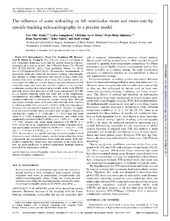| dc.description.abstract | Noninvasive measurements of myocardial strain and strain rate by speckle tracking echocardiography correlate to cardiac contractile state but also to load, which may weaken their value as indices of inotropy. In a porcine model, we investigated the influence of acute dynamic preload reductions on left ventricular strain and strain rate and their relation to the pressure-conductance catheter-derived preload recruitable stroke work (PRSW) and peak positive first derivative of left ventricular pressure (LV-dP/dtmax). Speckle tracking strain and strain rate in the longitudinal, circumferential, and radial directions were measured during acute dynamic reductions of end-diastolic volume during three different myocardial inotropic states. Both strain and strain rate were sensitive to unloading of the left ventricle (P < 0.001), but the load dependency for strain rate was modest compared with strain. Changes in longitudinal and circumferential strain correlated more strongly to changes in end-diastolic volume (r = −0.86 and r = −0.72) than did radial strain (r = 0.35). Longitudinal, circumferential, and radial strain significantly correlated with LV-dP/dtmax (r = −0.53, r = −0.46, and r = 0.86), whereas only radial strain correlated with PRSW (r = 0.55). Strain rate in the longitudinal, circumferential and radial direction significantly correlated with both PRSW (r = −0.64, r = −0.58, and r = 0.74) and LV-dP/dtmax (r = −0.95, r = −0.70, and r = 0.85). In conclusion, the speckle tracking echocardiography-derived strain rate is more robust to dynamic ventricular unloading than strain. Longitudinal and circumferential strain could not predict load-independent contractility. Strain rates, and especially in the radial direction, are good predictors of preload-independent inotropic markers derived from conductance catheter. | en_US |

